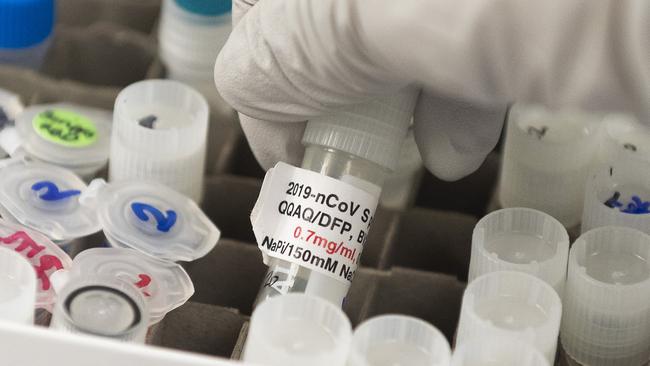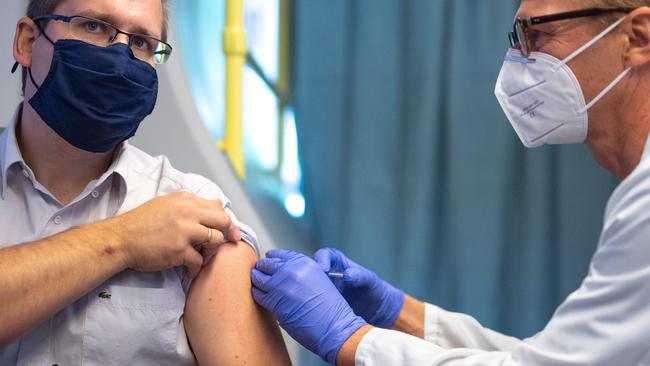Is budget assumption on COVID vaccine realistic?
The WHO says we may have a coronavirus vaccine by the end of the year, while the federal government is banking on one in the next 12 months — but experts say a general use vaccine won’t be available for some time. Here’s when we can expect one and why it could take so long.
HS Coronavirus News
Don't miss out on the headlines from HS Coronavirus News. Followed categories will be added to My News.
A coronavirus vaccine for general use won’t be available until at least 2022, experts say.
The head of the World Health Organisation last week said a vaccine may be possible by the end of 2020, while the federal government’s budget has been modelled on all Australians receiving a vaccine by the end of 2021.
But while a COVID-19 jab may possibly be released for health care workers and at-risk populations sooner — in early 2021 — experts predict it will be a longer wait for the masses.
That could be troubling result for Treasurer Josh Frydenberg.
In crunching the budget numbers, he assumes that the economy will get back to some sort of normality by that time, something that is only possible with a workable vaccine in widespread use.
Mr Frydenberg acknowledged those assumptions in interviews on Wednesday.
“This budget has some assumptions in there but the environment is very uncertain, it’s very fluid and primarily a health crisis. … if there is no vaccine then it will take longer to open those borders and that will in fact impact on that budget bottom line,” he told 3AW.
WHAT THE EXPERTS SAY
Doherty Institute immunology theme leader Professor Dale Godfrey said it was possible a vaccine would be released in limited ways by early next year.
“Early next year a vaccine may be available in limited ways for certain people, such as health care workers and people at high risk,” he said.

“It’s very hard to predict what these phase 3 trials will show us about vaccine safety and efficacy, and this will govern whether and when vaccines will become available.”
There’s currently 190 vaccine candidates worldwide, with 42 in clinical evaluation and 10 of those in phase 3 trials, according to the World Health Organisation.
Professor Godfrey said the Oxford University vaccine is a frontrunner, as it was well into phase 3 trials.
The Oxford trials did temporarily stall earlier in the year when one study participant experienced an adverse reaction, but Prof Godfrey says there was no reported evidence to suggest whether this person had received the vaccine or a placebo.
Other vaccines currently in phase 3 trials include United States’s company Moderna, China’s canSINO and Sinopharm, which is making two different vaccines and a vaccine by German company BioNtech and US company Pfizer.
Australian vaccines include University of Queensland’s spike trima, under early clinical trials, and one by Flinders University and pharmaceutical company Vaxine, under phase one.
Monash University Head of Microbiology Professor Stephen Turner also had faith in the Oxford University vaccine, as well as the one from University of Queensland.
“(UQ) released results recently which showed the vaccine induced good, robust immunity,” he said.
“Moderna is another one where I was initially sceptical, but now it’s showing good signs. Sinopharm’s clinical data also looks promising.”
Prof Godfrey is working on a vaccine with a team of investigators from the Doherty Institute and Monash University, which is currently in preclinical testing and hopes to enter phase 1 in the first half of next year.
He said it wasn’t likely the Doherty Institute/Monash vaccine would be ready for general use until 2022.

Prof Godfrey said once a vaccine was created, it would still take time to distribute widely in the community and to start providing protection.
“Vaccines work in two ways — they protect the individuals who get them and that should work within weeks of being immunised,” he said.
“Then there’s herd immunity and that’s when the whole community has enough people who are immune, that others who are not immunised are still protected because the virus is unable to spread effectively. Herd immunity will take longer as for this to work, 60 to 70 per cent (of the population) would need to be immune.”
“That is unlikely to happen until at least later next year or the year after.”
Prof Turner said we would see a vaccine at the end of these trials.
“We will get a vaccine, there’s multiple vaccines being trialled which means there is going to be choice. This may accelerate access to a vaccine quicker, rather than relying on one source to deploy this everywhere.”
COVID-19 VACCINE HOPEFULS
OXFORD VACCINE/ASTRAZENECA
England
Phase 3
The front runner vaccine that has entered phase 3 clinical trials. Trials stopped briefly after a participant experienced an adverse reaction. There’s no evidence to suggest whether the participant received the COVID-19 vaccine or a placebo. Pharmaceutical company CSL and AstraZeneca agreed to manufacture of approximately 30 million doses of the Oxford University vaccine, for supply to Australia with first doses scheduled for release early 2021, following successful clinical trials.
MODERNA
United States
Phase 3
First vaccine in the world to enter clinical trials. Uses an RNA based vaccine that looks at the genetic sequence of the virus.
CANSINO
China
Phase 3
Phase 3 trials are underway in Saudia Arabia, Pakistan and Russia, however the vaccine has been given early approval for the Chinese Military if they need to use it.
SINOPHARM
China
Phase 3
Chinese company Sinopharm as launched phase 3 in the United Arab Emirates, Peru and Morocco. It is developing two vaccines and has also been given approval for emergency use by health care workers.
PFIZER/BIONTECH/ FOSUN PHARMA
United States, Germany
Phase 3
Joint venture by US and Germany labs.
Australia
Pre-Clincal trials
Recently received funding through the Medical Research Future Fund to progress to clinical trials. Unlike the front runner vaccines, the team only began working on their vaccine early this year. The vaccine focuses on the ‘tip of the spike’ protein. “We believe this tip of the spike is the most important part of the virus to target with an immune response because this is the part that allows the virus to enter our cells,” Prof Godfrey said. The vaccine is likely to be released much later than those developed overseas, but it is also likely to offer some advantages that other vaccines in production may lack
UNIVERSITY OF QUEENSLAND
Australia
Phase 1
Known as the molecular clamp vaccine. On Wednesday, pharmaceutical company CSL and Australian Government agreed to supply 51 million doses of University of Queensland vaccine to Australia, with first doses scheduled for release from mid-2021 following successful clinical trials.
FLINDERS UNIVERSITY
Australia
Phase 1
A joint venture by Flinders University in South Australia and pharmaceutical company Vaxine.
MORE NEWS:
MIND-BOGGLING BUDGET BETTING ON VACCINE
DON’T BELIEVE HYPE ON RUSSIAN VACCINE
